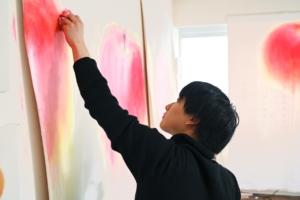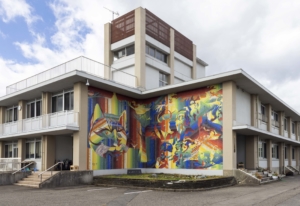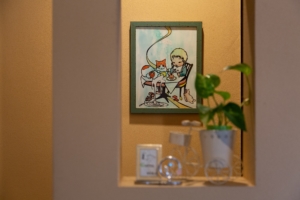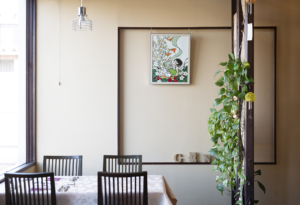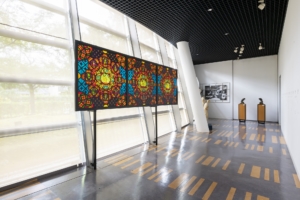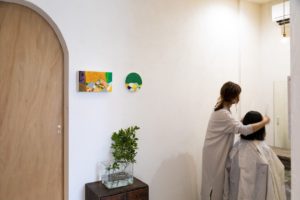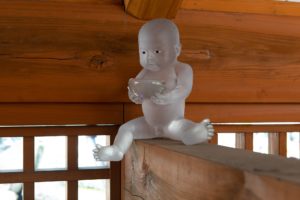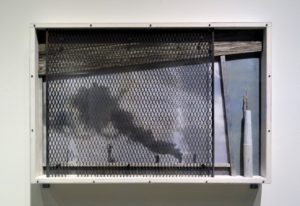Recently, scratchingart books have been crowded in bookstores and general stores. Some of readers may have actually bought a book and finished it.
It is a common scratchingart to finish a work by shaving a black sheet. However, WAKABAYASHI Tomomi’s scratchingart works are full of bright colors that completely change the conventional image.
I visited her house in Ono City, Fukui Prefecture, to interview the background of her work.
I remembered a technique called scratch because I wanted to draw with a sharp touch.
I heard that the cover illustration of Seiji (means celadon), a literary magazine written by your high school teacher, was the trigger for starting scratchingart in earnest.
In 2015, I drew Baguette, Petit France, Donut and so on from scratch using bread as a motif. The bright colored bread illustration was surprisingly popular. It was orangish on a white background.
Even before that, I had been drawing cover pictures and illustrations for Seiji. But instead of scratching, I used oil pastels, color inks, crayons and other art supplies. Motifs included chairs, shoes, and leaves.
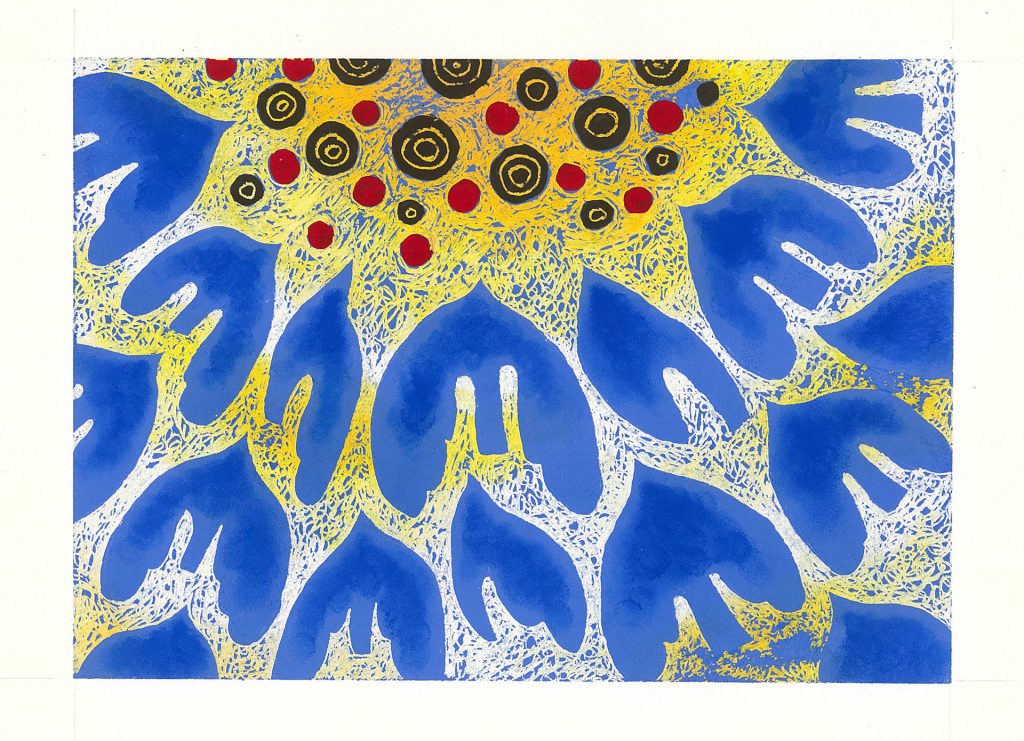
Why did you want to change your drawing materials and style?
I liked the soft gradation of crayons. When I started to draw illustrations, my child was too young to spend much time on the production. The soft expression of the crayons suited me.
However, the edge of the crayon is not sharp and it looks too soft. I wanted to draw a sharp painting, and I happened to recall a technique called scratching.
Have you ever seen or heard about scratching somewhere?
I remembered what I experienced when I was in kindergarten. “Come to think of it, crayons are art supplies that can be scratched.” I thought it was a win-win situation. It can be finished in soft gradations and have a distinct shape.
I also thought that the range of expression would expand if the layer to be painted on the surface was not limited to black. From that point on, I have been making my work focusing on scratching.
I think your work has a completely different look from the popular black-based scratchingart.
Because it uses a transparent crayon, people who know only black-based scratchingart often ask, “How did you draw it?” or “Is this also called scratchingart?”
Have you known about the existence of transparent crayons?
No, I had no idea. Whenever I went to the art supply store to buy something, I always wondered, “What color is this?” There was a number 000, which was a transparent crayon.
When I didn’t know about transparent crayons, I made scratchingart by spreading crayons over the base, layering thin white acrylic paint, and shaving off the acrylic paint to expose the base.
I’ve done it that way, and I’ve often scratched too much of the underlying crayon layer. I was also dissatisfied with the color saturation. I tried using colored paper instead of white paper, but it didn’t work very well.
Can I imagine a transparent crayon as a candle?
Yes. Transparent crayons are like a candle or a eraser.
The original purpose of transparent crayons is to blur the color when drawing with crayons. I came up with a way to use it as a remover. I thought it might be a good idea to paint a base with acrylic paint and then paint a layer of clear crayons over it. In that way, I drew 2 works, Midoriba 1 and Midoriba 2.
(Midoriba means green leaves)
Midoriba is the hero image on the website of the high school alumni association I graduated from. The client ordered me to draw as I wanted. So I tried a new way of drawing. It turned out to be very satisfactory and I felt it was my own scratching method.
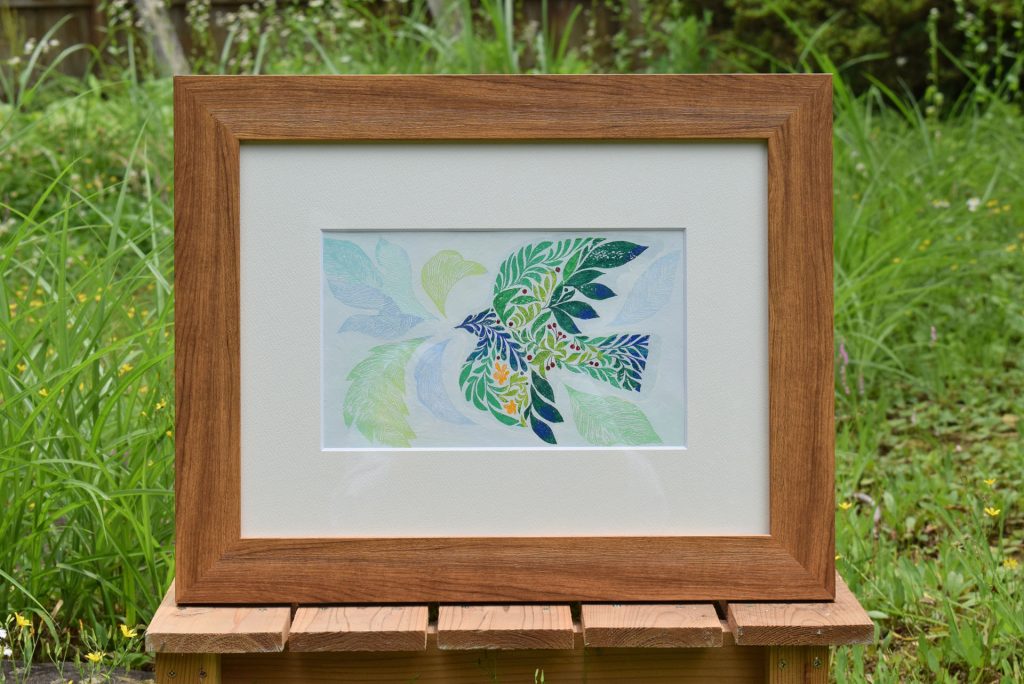
Birds are the most driving force of creation for me. It is hard to imagine creative works that are far from that.
Do you have an original experience of painting with a bird motif?
I have liked birds since I was a child, and when I was an elementary school student, I did a research project called the structure of a bird’s feathers. I remember being a 2nd grader and knowing that “The wind-face is the driving force of the bird.”
I studied many things. For example, “A waterfowl has a pile of downy hair, so the water doesn’t come in.” “The feather is greased, so it repels water.” So I still get excited when I see birds. I get very excited when there are herons or big birds nearby.
I like the shape of birds and I feel the beauty even if the birds are not flying. I’m excited to see the birds flying.
Most people regard crows as birds that hate them, but I think “Crows are also beautiful.” Birds are the driving force of creation and are a source of excitement.
I was in Tokyo when I was in my thirties. When I lived in Tokyo, I used to draw pictures in the motif of buildings. But I don’t think I can draw a city motif anymore. Because there are many beautiful things around me such as birds and flowers.
Are you not interested in motifs other than birds?
I also draw pictures of cats and bladder cherries like wireframes. It is different from the style I have drawn.
Tell me about drawing in wireframe. Is it an association from leaves like the one drawn in Midoriba?
I had seen the ornaments of a bladder cherry made only of veins. Seeing that, I felt, “It’s so beautiful.” Inspired by this, I drew the veins of the bladder cherry as a wire. And I also drew a plant ball inside of bladder cherry.
So I decided to paint something else with wires. There is something like a ball in the bladder cherry, but there is nothing else, so I felt something was missing. So I drew something like a heart. It is, so to speak, a cat version of the bladder cherry. Don’t you feel like a cell or a mitochondrion?
I have been painting works with wire motifs since the end of 2018. I want to draw more of this series.
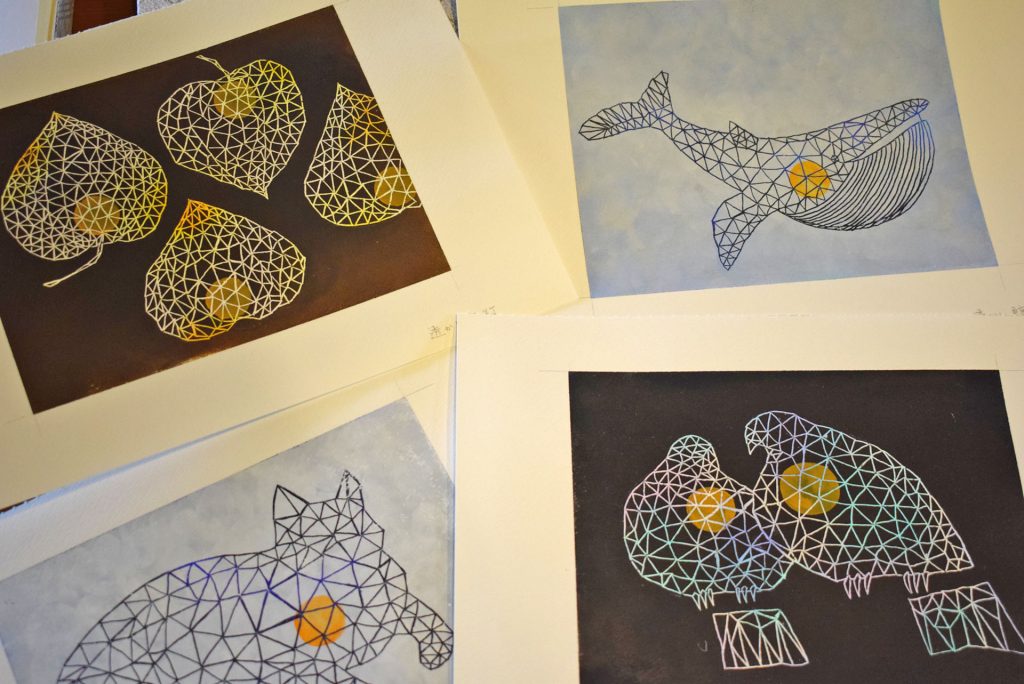
I feel that your work features bright colors. However, isn’t the brightness of the work with a wire motif a little low?
When I try to shine the wire, it still looks dark. It scratches as a line drawing, so if I make the surroundings bright, it doesn’t look beautiful unexpectedly even if I make the base of crayons gradation.
When I try to shine the wire, it still looks dark. It scratches as a line drawing, so if I make the surroundings bright, it doesn’t look beautiful unexpectedly even if I make the base of crayons gradation.
I see. In the case of wire, there are few parts where the color is exposed.
Because there are few exposed parts, if the background is bright, it will be buried. The Midoriba series scratches the entire surface and looks great on a white background.
There are so many things I want to draw, so the problem is how to make time. I want to try a series that combines two motifs, a bird and a leaf.
For example, flying birds and flowers in groups, or leaves and flying birds. Up until now, there have been many things that make use of gradation, but I would like to take a different approach.
I want to interact with various artists.
By the way, are there any elements that are common to the works you are attracted to?
That’s a difficult question. But I think children’s pictures are amazing.
Is it about your child’s painting?
No, about any children’s paintings. I find the boldness and detail of children’s paintings amazing.
For example, when they draw rice, they come across a scene in which they draw a rice bowl in a sloppy form, but they carefully draw every grain of rice. I admire such sensitivity. If there is a detailed pattern in a bold form, I feel it is wonderful.
In relation to this story, I felt that a large piece of work with both precision and bold margins might be good. Both of them express the size of the world. It’s a different approach from scratching a large surface with transparent crayons. It is like a landscape painting on a folding screen.
I also like the works that have missing details. It is almost suffocating to make a detailed work. For example, when I look at a work of over 10 meters in width, which is very detailed, I think it’s better to be able to breathe a little more. I appreciate such works.
When making a big work, it is hard to paint transparent crayons. I put more effort into painting transparent crayons than scratching. When I draw the cover of a book, the size is specified, so I can make a detailed scratch.
If I can make the foundation more efficiently, I think I can make a big work. However, I feel that if I draw it by repeating simple work, it will bring out my own thoughts and the texture of manual work.
Even if it’s done in an efficient way, I think it might be different. It took time and effort all the way. It may be just my self-satisfaction.
If you want to make a big work, you need to study drawing materials, don’t you?
I think a big work has its merits, and it can incorporate various elements. There is also a possibility that painting materials other than transparent crayons can be used as release agents.
I want to interact with various artists. It will lead to the study of painting materials, and it may be a hint to draw big works. I want to stimulate each other.
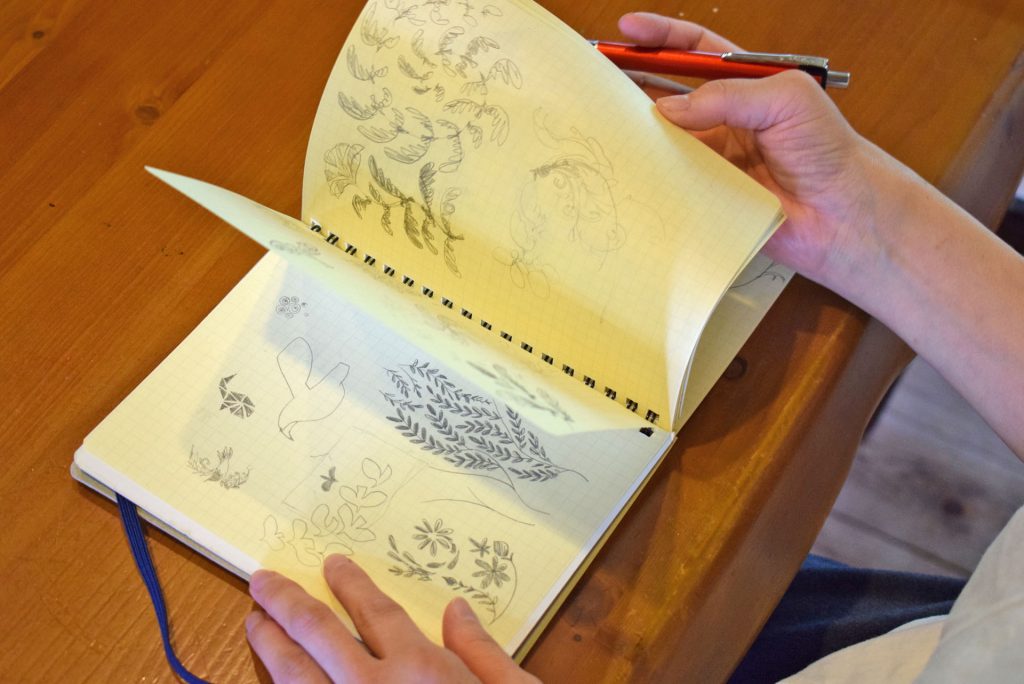
I want to do something that makes the viewer happy and moves their mind in a good direction.
Is your immediate goal to draw a big work?
That’s a difficult question (laughs). I want to paint a big picture, but that’s not my goal. One answer is that I don’t think much about it. Another answer is to draw according to the needs of people around me.
I don’t really think about goals for drawing. I continue my creative activities by painting one motif at a time like a coloring book. That may be a random way. Don’t you think so?
As in the Midoriba series, a new work was created by an order from a client. I think random is one way of creating.
I also think that my style will be determined while responding to people’s requests. Like Darwin’s theory of evolution, which refers to the adaptive capacity of animals.
On the other hand, there is my feeling that ‘I want to shake people’s feelings.’ at the base of the production. This is the feeling that I have had since my adolescence.
When I was impressed by watching movies and listening to music, I felt a sense of regret and impatience. It is the feeling of “How can I impress people?”. I wondered if I would die old without doing anything.
That doesn’t mean I can sing or write novels. I liked painting, but I wasn’t sure if I could do it with it.
I still have the feeling I had when I was a teenager. I want to move people’s feelings in some way.
Didn’t you do creative activities when you were a teenager?
I guess I didn’t do much creative work… I just drew pictures and cartoons. There was no such goal as becoming an illustrator or a painter in the future.
Even though I wanted to move people’s feelings, I didn’t want to move them in a painful way. There are various kinds of art.
For example, there are movies where you feel pain, right? But I don’t think this is what I can do.
If I could, I would like to do something that makes people happy and moves them in the right direction. I think that’s the driving force of my creation. So I don’t think I can draw radical pictures and I can’t. I can’t draw a picture that makes me feel sick.
In other words, did you get an item that can move people’s mind in the form of scratchingart?
That’s right. I feel like I got my only item. So I feel a little relieved now.
Even if I watch movies or listen to music, I don’t feel as frustrated or impatient as I did in my adolescence. I was able to find a place in my heart where I could say, “I have the means of expression of illustration at all times”.
When I see my work, I sometimes think, “IT’S PRETTY GOOD.” (laugh). Every time, trying to go beyond the past works is both painful and fun.
I’m a fan of Japanese singer-songwriter YONEZU Kenshi*. I like the vocaloid music that he made, but the recent songs whose sound is changing are also very good. I wonder how far his music will evolve.
*Please refer to official site(jp) and Wikipedia(en)
Even if I am deeply moved by his music, I can stand still. “I have my own item called illustration.”… I’m sorry, I quoted such a great person.
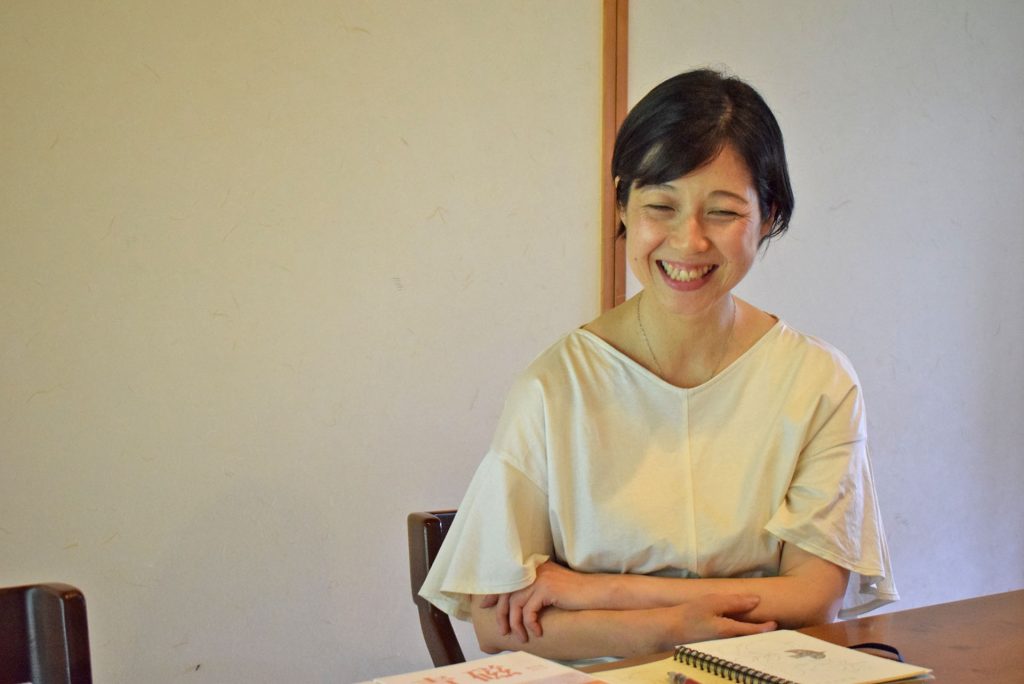
Profile
WAKABAYASHI Tomomi
Born in Fukui City, Fukui Prefecture
Graduated from Tsukuba University School of Art and Design.
After working for a design production company in Tokyo, she moved to Ono, Fukui Prefecture. She started scratchingart in earnest when she drew illustrations for a literary magazine Seiji edited by her teacher in high school.
She is good at brightly colored scratchingart based on acrylic painting. Currently, she continues to create various motifs, such as the A Bird or … series in which a flock of birds is likened to a flower petal.
Portfolio
https://www.behance.net/gallery/78785021/Scratch-Art-01
Part of the work is currently being sold in the GEISEN.art store.
https://store.geisen.art/product-tag/wakabayashi-tomomi
